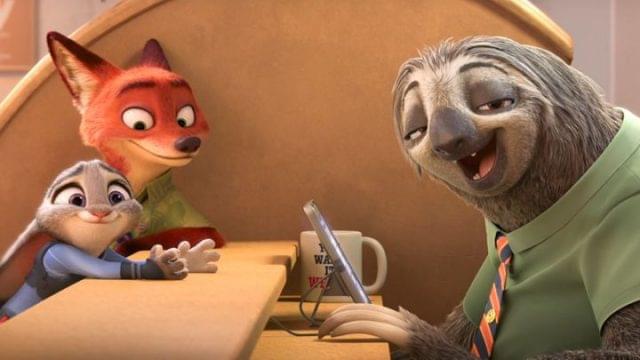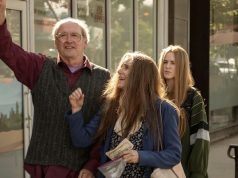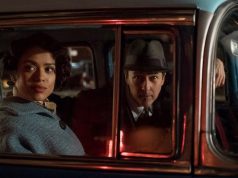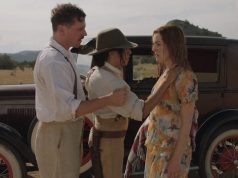
The credo of the city of Zootopia, as featured in the movie “Zootopia,” is that it doesn’t matter what kind of animal you are — “anyone can be anything.” It’s essentially the same “be yourself” message found in every Disney cartoon, but this time there’s a twist: the movie is about race relations.
Oh, I know! I would roll my eyes, too. But this shrewd, funny buddy-cop story about anthropomorphic animals pulls it off without a hint of preachiness. How? By inventing situations that mimic real-life issues without (for the most part) being direct parallels to them, and by not following a consistent pattern of this animal representing that race, and so forth. In an early scene, a bunny seems to be the stand-in for African Americans, bullied by a fox (with a redneck Southern accent) who pledges to keep bunnies in their place. But in other scenes, it’s the bunnies who represent white bigots, with foxes as the oppressed, mistrusted class. In still other scenes, the corollaries are broader — not foxes and bunnies, but predators and prey, or large animals vs. small ones.
In short, each animal has its moments of prejudice and acceptance, of being right and being wrong, of being fearful and being brave. By not letting the story be boiled down to one simple allegory, “Zootopia” conveys its message without being political, inflammatory, or controversial. You might say this dilutes it, that it would have been more effective if they’d gone all the way with #foxlivesmatter. But that’s too narrow a view, and a potential turnoff for audiences (who, after all, just want to see a funny cartoon about talking animals). The movie’s broader take is one that only a die-hard racist could disagree with: that we can acknowledge the differences between our “species” without being unequal, and that while our feelings of bigotry and fear often come from honest emotional reactions (the bunny really did have a traumatic experience with a fox), we must overcome those impulses and judge one another as individuals, not as groups.
Also, no matter how “different” it looks to you, don’t touch the lamb’s woolly hair without her permission. And I know you hear bunnies call each other “cute,” but it’s kind of offensive when non-bunnies use that term. And just watch that fox cringe when someone refers to him as “articulate.” You get the idea.
“Zootopia” is set in a world where predators and prey evolved into a peaceful co-existence and live in human-like cities together. (It’s never explained what the predators eat instead of other animals, nor is there any reference to humans or non-mammals. Just go with it.) Judy Hopps (voice of Ginnifer Goodwin), an optimistic young rabbit, is the first of her species to become a police officer in the bustling metropolis of Zootopia. Not taken seriously by Chief Bogo (Idris Elba), a water buffalo, or by any of her fellow cops, who are various mid-sized animals, she’s assigned to be a meter maid.
Undaunted, Judy Hopps is determined to make a difference in her community. She takes on a “missing mammal” case that no one else has time for because she’s touched by Mrs. Otterton’s (Octavia Spencer) pleas for help. And in the process of investigating, she teams up with a street-wise con artist named Nick Wilde (Jason Bateman), a sly fox who challenges Judy’s preconceived notions about foxes (and who has some serious trust issues with police).
Directed by Byron Howard (“Tangled”) and Rich Moore (“Wreck-It Ralph”), and written by Phil Johnston (“Cedar Rapids,” “Wreck-It Ralph”) and Jared Bush, the film is modeled on the buddy-cop formula, following that pattern of clue-finding, false leads, red herrings, and eventual mystery-solving. But it also discovers many clever ways to exploit the animals-as-humans setting, including a nudist colony run by a hippie yak (Tommy Chong), a DMV staffed entirely by sloths, and an arctic shrew who’s a Mafia kingpin. There are gags based on the relative size of the animals (Judy is a giant in the Little Rodentia neighborhood) and on the human-like rules applied to them (as when an employee at an elephant-owned ice cream shop is chastised for spraying toppings out of his trunk).
It’s consistently cheerful and funny, never heavy-handed, even when serious issues are being hinted at. Kids will undoubtedly enjoy it (what brightly colored entertainment with talking animals DON’T kids enjoy?), but this one seems meant more for adults who can appreciate its ingeniously fabricated world and its big-hearted ideals.
B+ (1 hr., 48 min.; )





